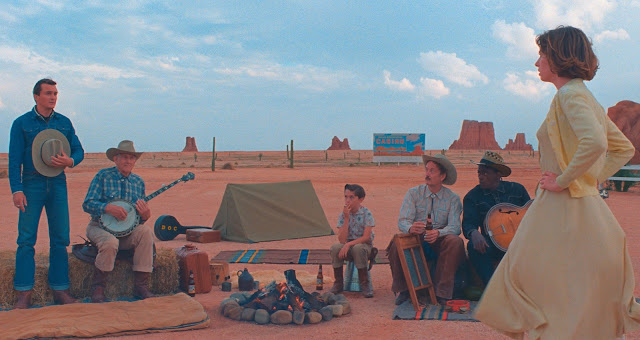"I still don't understand the play."

Focus Features / Indian Paintbrush
Starring many famous faces but largely centred around Jason Schwartzman's widowed war photographer father, his awkward stargazing son (Jake Ryan), Tom Hanks as Schwartzman's gruff father-in-law, and Scarlett Johansson's divorced movie star mother rehearsing a role, we're introduced to most of the lonely characters as actors playing parts in a deliberately contrived three-act stageplay (black and white segments narrated by Rod Serling-like Bryan Cranston) being performed for live television special in 1955. It's a play within a teleplay within a film.
Then we enter the (pastel coloured) world of the actual Asteroid City, an American desert town of eighty-seven consisting of a motel, diner, gas station, unoccupied land, and crater, where a teen science fair sets off a possible extraterrestrial event. Everything about Asteroid City (the film we're watching) feels so expertly bespoke as to say it's purposely distancing.

There's a precision to the sharp humour overstuffed with bit parts and cameos by movie stars from the likes of Edward Norton, Adrien Brody, Liev Schreiber, and Steve Carell whose souls jobs are to enhance the exhilaratingly surreal world we're in. It's meticulously dizzying with extended shots, whip pans, and stilted dialogue that burst with energy and flair the way only a distinctly Wes Anderson film can.
Every vivid frame of the stylish film does indeed feel like a painting through its immaculate visual composition. Anderson's use of the static medium of theatre and constructed stages or sets contrasts his clear cinematic precision of style to enhance the subtle performances of his brimming cast of players.
Asteroid City is purposely all about artifice of storytelling expressed through grief. Anderson delightfully announces this through the self-reflexive structure of stage narration and the film as a play. It's a densely multi-layered meta-narrative tale of detached families told as a diorama. Much of what is seen seems ingenious as a piece of film construction just as likely to delight viewers as it is to turn off those unfamiliar with the Andersonian canon.
More | YVArcade / Gate / Indiewire / Inverse







0 reactions:
Post a Comment